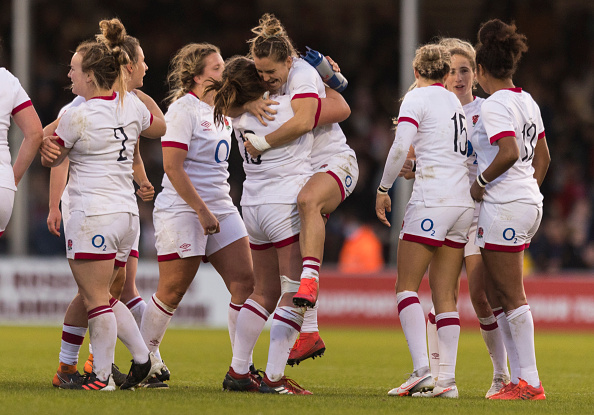England’s women wrapped up their fourth consecutive Six Nations title and are looking like strong favourites for the upcoming Rugby World Cup later this year. While a winning run of 23 matches may sound bad for the health of the sport due to a lack of competition, it does serve to force other unions into more significant action if they have any aspirations of success. Here we look at how the Red Roses are driving growth in the sport.
🏆 CHAMPIONS 🏆
Record breakers. History makers. This team is special 👏👏👏#RedRoses pic.twitter.com/HbC3zWadph
— England Rugby (@EnglandRugby) April 30, 2022
The Red Roses’ growth and how it is changing the game
A push for professionalism
England was the first women’s side to go fully professional when they handed out 28 full-time contracts in 2019. Since then they have firmly established themselves as the dominant force in the sport. They have shown that to grow the sport you need to invest. More impressively though they have shown that the investment leads to results.
This has forced other nations to follow suit. While they are not as cash-rich, pitting amateurs against professionals is never going to be a fair fight. As such other nations are starting to realise this and pay more than just lip service to women’s sports. France and Wales both now have a mixture of full-time and part-time deals with several players. Add in Italy who during the tournament announced that it would be awarding central contracts ahead of the World Cup. This still leaves Ireland and Scotland in a complete amateur status. Professional contracts are almost a taboo subject in Irish rugby. This shows on the pitch too with Ireland failing to qualify for the upcoming World Cup while Scotland had to go through the qualifiers to secure their place.
A big step forward for @Federugby as they build towards the @rugbyworldcup in New Zealand later this year#RWC2021 pic.twitter.com/nWGQQC55ND
— World Rugby (@WorldRugby) April 13, 2022
There is a long way to go until women are rightly rewarded for the work they are putting into the sport but the efforts made by the English Women to show that money spent on them is well spent has gone a long way to pushing for more nations to do the same.
Professionalism does not just mean giving out contracts. It means providing an environment of a suitable quality so these athletes perform at their best. This includes ensuring that a team never suffers the embarrassment of having to get changed next to the bins as was the case during an interprovincial match in Ireland in 2019. In addition, it includes creating a professional culture among the players, coaches and other support staff. The recently published review of the culture of New Zealand’s Black Ferns shows that we still have a long way to go here.
Players reported the management showing cultural insensitive behaviour as well as favouritism. Further accusations of swearing at players and players feeling like they were walking on eggshells paint an incredibly grim picture of the environment in New Zealand. This all came off the back of a disastrous European tour which saw heavy defeats to England and France. Originally fans and the media put down to COVID-19 robbing the Black Ferns of playing time, unlike their European opposition. A post on social media though by Te Kura Ngata-Aerengamate led to the review showing how much was truly wrong with New Zealand rugby. Reviews should not be how we measure our failures though, by that stage it has already gone too far. Canada is another example of this and as a sport, we all need to do better.
🥲 These words from @rubytui! 2022 is gonna be good. https://t.co/1fTe3Brsdk
— All Blacks (@AllBlacks) May 4, 2022
If the hosts of the upcoming World Cup have hopes of success, they are going to have to change fast. The environment in the camp of their biggest rivals, France and England, looks an exciting place to be. France has the only female head coach in the Six Nations, Annick Hayraud, who provides that element of physiological safety in a sport dominated by the opposite gender. England meanwhile is showing that money is king. They are bringing in the best coaches and nutritionists and making sure that everything the players need is provided. Fundamentally though, the noises coming out of both camps are that the people involved are not just good at their job, they’re good people too and that is something often lost in the cutthroat world of sport.
The Red Roses’ impact trickled into the growth of the domestic league
Alongside the incredible national side, England also has one of the best domestic leagues. The Premier 15s has some of the best players from around the world. Capped internationals from Ireland, Scotland, Wales, Canada, South Africa, Japan and the USA among others make it a diverse and competitive league that everyone wants to be a part of.
The professional contracts given to the selected England players only help to raise the standard. These players push the standard and help those around them to be better. Furthermore, the appetite shown for women’s rugby during the Red Roses’ international fixtures helped market the league. As such the BBC now shows a number of the domestic games live on free-to-view television. This further boosts the profile of the sport as access to the game has never been easier. Whereas before every viewable match was on a streaming service online that some found difficult to access, the BBC provides high-quality content in a well-known location.
📺 Premier 15s rugby union will be broadcast live on the BBC for the first time, starting this weekend with Bristol Bears Women v Wasps.
A selected game will be available to watch each weekend on BBC iPlayer and BBC Sport website and app.
👉 https://t.co/s3U6QhKXLz pic.twitter.com/AcbmS3jX1e
— BBC Sport Bristol (@bbcbristolsport) November 26, 2021
Not only do the Red Roses improve the standard of those around them, but they also provide an incentive to players across the globe to come to the Premier 15s to test themselves against the best. With few domestic women’s leagues currently existing, the Premier 15s sets itself apart as the place to play women’s rugby.
The Red Roses are seeing huge growth in crowds
The Red Roses set a new world record for a stand-alone women’s rugby fixture when they played Wales at Kingsholm. They then proceeded to topple the record in their very next home game. This time 15,836 fans saw them put in an excellent performance to beat Ireland. They are setting the benchmark there is no doubt about it but other nations are starting to see similar results. Scotland has seen the record attendance for a women’s home game broken and Wales and Ireland have done the same.
𝘼 𝙧𝙚𝙘𝙤𝙧𝙙 𝙖𝙩𝙩𝙚𝙣𝙙𝙖𝙣𝙘𝙚🙌
Another new #RedRoses home @Womens6Nations attendance record.
Thank you for your support!#ENGvIRE pic.twitter.com/BhsP18MtMr
— England Rugby (@EnglandRugby) April 24, 2022
A large part of this is because the women’s tournament now has a different time slot than the men’s. This means there is no competition between the two for viewing figures. TikTok as a sponsor is doing wonders for the sport as it reaches a new audience of young fans. The quality of rugby cannot be ignored though. While England’s home games were not close affairs, they were hugely entertaining. These matches showed that there is a market for women’s rugby and if that can be harnessed effectively it is not just England who can enjoy crowds of that size. England should continue to push and we may soon see the Red Roses walkout to a fully packed Twickenham.
The future growth of the sport
The Red Roses have shown the world what growth is possible, but they will believe they have only scratched the surface. The evidence is clear that the women’s game has huge potential for growth on the field and in its bureaucracy and if changes are not made to realise this potential, those stuck in their current ways will get left behind. Women’s rugby is growing, it is up to those in charge to grow with it.
Main Picture Credit:
Embed from Getty Images



